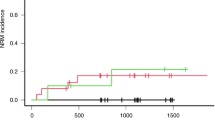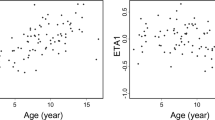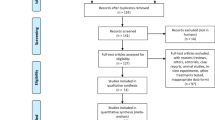Abstract
BU is used in conditioning regimens before hemopoietic SCT. High BU exposure is associated with toxicity, whereas low BU exposure leads to higher rates of therapy failure. The pharmacokinetics of BU show large interpatient variability, hypothesized to be caused by variability in BU metabolism. In this report, the effect of genetic polymorphisms in three gluthatione S-transferase genes involved in BU metabolism (hGSTA1), GSTM1 (deletion–mutation) and GSTP1 (313A/G) on the pharmacokinetics of BU in Caucasian adult patients was investigated. In all, 66 adult patients received BU as part of their conditioning regimen. After the first infusion, two serum samples were collected and measured using a HPLC assay. A one-compartment population model was used to estimate individual pharmacokinetic parameters. The genetic variants of the three glutathione S-transferase (GST) genes were determined by pyrosequencing and PCR. A reduction of 14% in BU clearance was seen for the GSTA1*B allele and an increase in BU exposure was found. No relationship was found between polymorphisms in GSTM1 and GSTP1 and BU pharmacokinetics. This study shows that an increasing number of copies of GSTA1*B allele results in a significant decrease of BU clearance.
This is a preview of subscription content, access via your institution
Access options
Subscribe to this journal
Receive 12 print issues and online access
$259.00 per year
only $21.58 per issue
Buy this article
- Purchase on Springer Link
- Instant access to full article PDF
Prices may be subject to local taxes which are calculated during checkout


Similar content being viewed by others
References
Grochow L, Jones R, Brundrett R, Braine H, Chen T, Saral R et al. Pharmacokinetics of busulfan: correlation with veno-occlusive disease in patients undergoing bone marrow transplantation. Cancer Chemother Pharmacol 1989; 25: 55–61.
Slattery J, Clift R, Buckner C, Radich J, Storer B, Bensinger W et al. Marrow transplantation for chronic myeloid leukemia: the influence of plasma busulfan levels on the outcome of transplantation. Blood 1997; 89: 3055–3060.
Andersson B, Kashyap A, Gian V, Wingard J, Fernandez H, Cagnoni P et al. Conditioning therapy with intravenous busulfan and cyclophosphamide (IV BuCy2) for hematologic malignancies prior to allogeneic stem cell transplantation: a phase II study. Biol Blood Marrow Transplant 2002; 8: 145–154.
Czerwinski M, Gibbs J, Slattery J . Busulfan conjugation by glutathione S-transferases alpha, mu, and pi. Drug Metab Dispos 1996; 24: 1015–1019.
Coles B, Morel F, Rauch C, Huber W, Yang M, Teitel C et al. Effect of polymorphism in the human glutathione S-transferase A1 promoter on hepatic GSTA1 and GSTA2 expression. Pharmacogenetics 2001; 11: 663–669.
Arand M, Mühlbauer R, Hengstler J, Jäger E, Fuchs J, Winkler L et al. A multiplex polymerase chain reaction protocol for the simultaneous analysis of the glutathione S-transferase GSTM1 and GSTT1 polymorphisms. Anal Biochem 1996; 236: 184–186.
Bell DA, Taylor JA, Paulson DF, Robertson CN, Mohler JL, Lucier GW . Genetic risk and carcinogen exposure: a common inherited defect of the carcinogen-metabolism gene glutathione S-transferase M1 (GSTM1) that increases susceptibility to bladder cancer. J Natl Cancer Inst 1993; 85: 1159–1164.
Kelada S, Stapleton P, Farin F, Bammler T, Eaton D, Smith-Weller T et al. Glutathione S-transferase M1, T1, and P1 polymorphisms and Parkinson's disease. Neurosci Lett 2003; 337: 5–8.
li-Osman F, Akande O, Antoun G, Mao J, Buolamwini J . Molecular cloning, characterization, and expression in Escherichia coli of full-length cDNAs of three human glutathione S-transferase Pi gene variants. Evidence for differential catalytic activity of the encoded proteins. J Biol Chem 1997; 272: 10004–10012.
Zwaveling J, Press R, Bredius R, van Derstraaten T, den HJ, Bartelink I et al. Glutathione S-transferase polymorphisms are not associated with population pharmacokinetic parameters of busulfan in pediatric patients. Ther Drug Monit 2008; 30: 504–510.
Cremers S, Schoemaker R, Bredius R, den Hartigh J, Ball L, Twiss I et al. Pharmacokinetics of intravenous busulfan in children prior to stem cell transplantation. Br J Clin Pharmacol 2002; 53: 386–389.
Cremers S, Schoemaker R, Bredius R, den HJ, Ball L, Twiss I et al. Pharmacokinetics of intravenous busulfan in children prior to stem cell transplantation. Br J Clin Pharmacol 2002; 53: 386–389.
Chow D, Bhagwatwar H, Phadungpojna S, Andersson B . Stability-indicating high-performance liquid chromatographic assay of busulfan in aqueous and plasma samples. J Chromatogr lB Biomed Sci Appl 1997; 704: 277–288.
Proost JH, Meijer DK . MW/Pharm, an integrated software package for drug dosage regimen calculation and therapeutic drug monitoring. Comput Biol Med 1992; 22: 155–163.
Zwaveling J, Bredius R, Cremers S, Ball L, Lankester A, Teepe-Twiss I et al. Intravenous busulfan in children prior to stem cell transplantation: study of pharmacokinetics in association with early clinical outcome and toxicity. Bone Marrow Transplant 2005; 35: 17–23.
Proost JH . Adaptive control of drug dosage regimens using maximum a posteriori probability Bayesian fitting. Int J Clin Pharmacol Ther 1995; 33: 531–536.
McDonald GB, Hinds MS, Fisher LD, Schoch HG, Wolford JL, Banaji M et al. Veno-occlusive disease of the liver and multiorgan failure after bone marrow transplantation: a cohort study of 355 patients. Ann Intern Med 1993; 118: 255–267.
Glucksberg H, Storb R, Fefer A, Buckner CD, Neiman PE, Clift RA et al. Clinical manifestations of graft-versus-host disease in human recipients of marrow from HL-A-matched sibling donors. Transplantation 1974; 18: 295–304.
Abassi N, Vadnais B, Knutson JA, Blough DK, Kelly EJ, O′Donnell PV et al. Pharmacogenetics of intravenous and oral busulfan in hematopoietic cell transplant recipients. J Clin Pharmacol 2010 (e-pub ahead of print; doi: 10.1177/0091270010382915).
Elhasid R, Krivoy N, Rowe JM, Sprecher E, Adler L, Elkin H et al. Influence of glutathione S-transferase A1, P1, M1, T1 polymorphisms on oral busulfan pharmacokinetics in children with congenital hemoglobinopathies undergoing hematopoietic stem cell transplantation. Pediatr Blood Cancer 2010; 55: 1172–1179.
Kusama M, Kubota T, Matsukura Y, Matsuno K, Ogawa S, Kanda Y et al. Influence of glutathione S-transferase A1 polymorphism on the pharmacokinetics of busulfan. Clin Chim Acta 2006; 368: 93–98.
Kim S, Lee J, Hur E, Lee J, Kim D, Lim S et al. Influence of GST gene polymorphisms on the clearance of intravenous busulfan in adult patients undergoing hematopoietic cell transplantation. Biol Blood Marrow Transplant 2011 (e-pub ahead of print; doi: 10.1016/j.bbmt.2010.12.708).
Srivastava A, Poonkuzhali B, Shaji R, George B, Mathews V, Chandy M et al. Glutathione S-transferase M1 polymorphism: a risk factor for hepatic venoocclusive disease in bone marrow transplantation. Blood 2004; 104: 1574–1577.
Acknowledgements
We acknowledge Dr WAF Marijt for collecting DNA samples.
Author information
Authors and Affiliations
Corresponding author
Ethics declarations
Competing interests
The authors declare no conflict of interest.
Rights and permissions
About this article
Cite this article
ten Brink, M., Wessels, J., Hartigh, J. et al. Effect of genetic polymorphisms in genes encoding GST isoenzymes on BU pharmacokinetics in adult patients undergoing hematopoietic SCT. Bone Marrow Transplant 47, 190–195 (2012). https://doi.org/10.1038/bmt.2011.55
Received:
Revised:
Accepted:
Published:
Issue Date:
DOI: https://doi.org/10.1038/bmt.2011.55
Keywords
This article is cited by
-
Effects of combined test dose and therapeutic drug monitoring strategy in exposure-directed busulfan
Annals of Hematology (2023)
-
Population pharmacokinetic analysis of intravenous busulfan: GSTA1 genotype is not a predictive factor of initial dose in Chinese adult patients undergoing hematopoietic stem cell transplantation
Cancer Chemotherapy and Pharmacology (2020)
-
Pharmacometabolomics for predicting variable busulfan exposure in paediatric haematopoietic stem cell transplantation patients
Scientific Reports (2017)
-
Once-daily i.v. BU-based conditioning regimen before allogeneic hematopoietic SCT: a study of influence of GST gene polymorphisms on BU pharmacokinetics and clinical outcomes in Chinese patients
Bone Marrow Transplantation (2015)
-
The association of cytochrome P450 genetic polymorphisms with sulfolane formation and the efficacy of a busulfan-based conditioning regimen in pediatric patients undergoing hematopoietic stem cell transplantation
The Pharmacogenomics Journal (2014)



